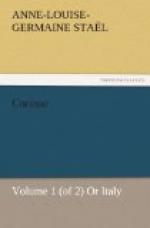Romeo and Juliet is an Italian subject; the scene is placed in Verona, where is still to be seen the tomb of those two lovers. Shakespeare has written this piece with that Southern imagination at once impassioned and pleasing; that imagination which triumphs in happiness, but which, nevertheless, passes so easily from happiness to despair, and from despair to death. The impressions are rapid; but one easily feels that these rapid impressions will be ineffaceable. It is the force of nature, and not the frivolity of the heart, which beneath an energetic climate hastens the development of the passions. The soil is not light, though vegetation is prompt; and Shakespeare has seized, more happily than any other foreign writer, the national character of Italy and that fecundity of the mind which invents a thousand ways of varying the expression of the same sentiments—the oriental eloquence which makes use of all the images of nature to paint what is passing in the heart. It is not as in Ossian, one same tint, one uniform sound which responds constantly to the most sensitive chords of the heart; the multiplied colours that Shakespeare employs in Romeo and Juliet, do not give a cold affectation to his style; it is the ray divided, reflected, and varied, which produces these colours, in which we ever feel that fire they proceed from. There is a life and a brilliancy in this composition which characterise the country and the inhabitants. The play of Romeo and Juliet translated into Italian would only seem to return to its mother tongue.
The first appearance of Juliet is at a ball, where Romeo Montague has introduced himself into the house of the Capulets, the mortal enemies of his family. Corinne was dressed in a charming festive habit, conformable to the costume of the times. Her hair was tastefully adorned with precious stones and artificial flowers. Her friends did not know her on her first appearance, till her voice discovered her: her figure then became familiar to them; but it was in a manner deified, and preserved only a poetical expression. The theatre resounded with unanimous applause upon her appearance. Her first looks discovered Oswald, and rested upon him—a spark of joy, a lively and gentle hope, was painted in her countenance: on beholding her, every heart beat with pleasure and fear: it was felt that so much felicity could not last upon earth; was it for Juliet, or Corinne, that this presentiment was to be verified?




